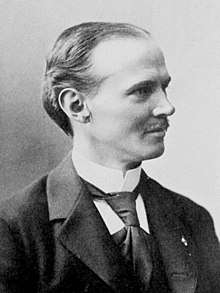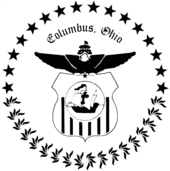Samuel Luccock Black
Samuel Luccock Black (December 22, 1859 – June 18, 1929) was a Democratic politician from the U.S. state of Ohio who served as 32nd Mayor of Columbus, Ohio for one two-year period and was later a judge.
Samuel Luccock Black | |
|---|---|
 | |
| 32nd Mayor of Columbus | |
| In office 1897–1898 | |
| Preceded by | Cotton H. Allen |
| Succeeded by | Samuel J. Swartz |
| Personal details | |
| Born | December 22, 1859 Kimbolton, Guernsey County, Ohio |
| Died | June 18, 1929 (aged 69) |
| Resting place | Green Lawn Cemetery Columbus, Ohio |
| Political party | Democratic |
| Spouse(s) | Catherine Nelson Black[1][2] |
| Alma mater | Ohio Wesleyan University |
| Profession | Lawyer Probate Judge Mayor |
Biography
Samuel Luccock Black was born December 22, 1859 in Kimbolton, Guernsey County, Ohio.[3][4] His parents were William Black and Marie Luccock.[4] He graduated at the public schools of Cambridge, Ohio in 1878, and Ohio Wesleyan University in 1883. He studied law and was admitted to the bar in 1887.[4]
Black moved to Columbus, Ohio immediately after admission to the bar and set up practice with Powell, Owen, Ricketts, and Black. He continued private practice until elected a judge. He first ran for office in 1896 for Probate Judge of Franklin County, but lost to Tod B. Galloway. He ran for Mayor of Columbus and defeated Republican Emmett Tompkins in the spring of 1897.[4] While he was mayor, the Union Station was completed, the municipal electric light plant and West Side levee (on the Scioto River) were completed, and the water system was improved.[5] He ran for re-election in the mayoral election of 1899, but was defeated by Republican Samuel J. Swartz.[4]
Black was elected Probate Judge of Franklin County November 1902, and was seated February, 1903.[4] He later transferred to a newly created Juvenile Court. He retired and resumed private practice in 1917.[5]
Black died June 18, 1929, and is interred at Green Lawn Cemetery, Columbus, Ohio.[6]
References
- "Catherine "Carrie" Nelson Black; 2009 Great Ohioans Chosen: Six Individuals Chosen to be Part of Special Statehouse Museum Exhibit". Ohio Statehouse Press Releases. Columbus, Ohio: Statehouse Communications Office, The Ohio Statehouse. January 27, 2009. Retrieved 18 November 2013.
- "Our Founder and Her Vision - Carrie Nelson Black, Humanitarian (1859-1936)" (PDF). The Breathing Association. Columbus, Ohio. pp. 3–4.
- Herringshaw, Thomas William, ed. (1909). Herringshaw's national library of American biography. 1. Chicago: American Publishers Assn. p. 341.
- Mercer, James K.; Rife, Edward K. (1903). Representative men of Ohio, 1900-1903. Columbus: James K. Mercer. pp. 211–213.
- Egger, Charles, ed. (1975). Columbus Mayors (PDF). Columbus: Columbus Citizen-Journal. p. 36.
- Green Lawn Cemetery Burial Records
External links
- Samuel Luccock Black at Find a Grave
- Samuel Luccock Black at Political Graveyard
| Political offices | ||
|---|---|---|
| Preceded by Cotton Hayden Allen |
Mayor of Columbus, Ohio 1897-1898 |
Succeeded by Samuel Jackson Swartz |
